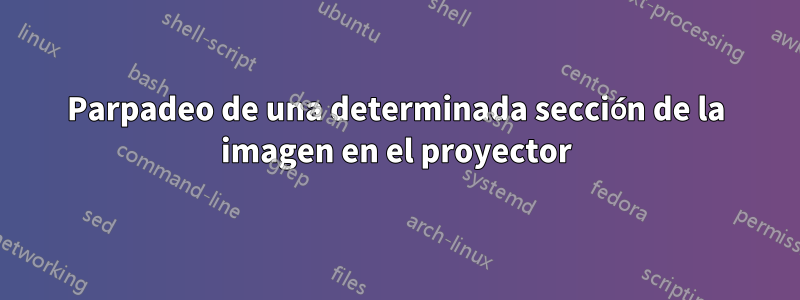
Dibujé una imagen en látex usando tikz como lo indica el siguiente código. La imagen generada a través del siguiente código consta de un bloque rectangular que tiene un texto E(s) escrito en su interior. Quiero hacer que este cuadro rectangular junto con el texto dentro parpadee y brille intensamente (centelleante). ¿Cómo puedo hacerlo?
\documentclass[compress, xcolor=table, usenames,dvipsnames]{beamer}
\usepackage{tikz}
\begin{document}
\tikzset{every picture/.style={line width=0.75pt}} %set default line width to 0.75pt
\begin{frame}{Figure}
\begin{tikzpicture}[x=0.75pt,y=0.75pt,yscale=-1,xscale=1]
%uncomment if require: \path (0,235); %set diagram left start at 0, and has
height of 235
%Rounded Rect [id:dp22728745820859309]
\draw (134,66.75) .. controls (134,62.33) and (137.58,58.75) ..
(142,58.75) -- (196,58.75) .. controls (200.42,58.75) and (204,62.33) ..
(204,66.75) -- (204,90.75) .. controls (204,95.17) and (200.42,98.75) ..
(196,98.75) -- (142,98.75) .. controls (137.58,98.75) and (134,95.17) ..
(134,90.75) -- cycle ;
%Rounded Rect [id:dp23074367111159821]
\draw (254,64.75) .. controls (254,60.33) and (257.58,56.75) ..
(262,56.75) -- (316,56.75) .. controls (320.42,56.75) and (324,60.33) ..
(324,64.75) -- (324,88.75) .. controls (324,93.17) and (320.42,96.75) ..
(316,96.75) -- (262,96.75) .. controls (257.58,96.75) and (254,93.17) ..
(254,88.75) -- cycle ;
%Straight Lines [id:da3785057523496602]
\draw (205,77.75) -- (251.5,76.79) ;
\draw [shift={(253.5,76.75)}, rotate = 538.8199999999999] [color={rgb,
255:red, 0; green, 0; blue, 0 } ][line width=0.75] (10.93,-3.29) ..
controls (6.95,-1.4) and (3.31,-0.3) .. (0,0) .. controls (3.31,0.3) and
(6.95,1.4) .. (10.93,3.29) ;
%Shape: Circle [id:dp7405273795099738]
\draw (350,76.5) .. controls (350,66.7) and (357.95,58.75) ..
(367.75,58.75) .. controls (377.55,58.75) and (385.5,66.7) .. (385.5,76.5)
.. controls (385.5,86.3) and (377.55,94.25) .. (367.75,94.25) .. controls
(357.95,94.25) and (350,86.3) .. (350,76.5) -- cycle ;
%Straight Lines [id:da4768143479707079]
\draw (323.75,77) -- (349.25,77) ;
\draw [shift={(351.25,77)}, rotate = 180] [color={rgb, 255:red, 0; green,
0; blue, 0 } ][line width=0.75] (10.93,-3.29) .. controls (6.95,-1.4)
and (3.31,-0.3) .. (0,0) .. controls (3.31,0.3) and (6.95,1.4) ..
(10.93,3.29) ;
%Shape: Circle [id:dp9725542364076398]
\draw (70,78.5) .. controls (70,68.7) and (77.95,60.75) .. (87.75,60.75)
.. controls (97.55,60.75) and (105.5,68.7) .. (105.5,78.5) .. controls
(105.5,88.3) and (97.55,96.25) .. (87.75,96.25) .. controls (77.95,96.25)
and (70,88.3) .. (70,78.5) -- cycle ;
%Straight Lines [id:da10367925110615261]
\draw (105.5,78.5) -- (135.75,78.5) ;
\draw [shift={(137.75,78.5)}, rotate = 180] [color={rgb, 255:red, 0;
green, 0; blue, 0 } ][line width=0.75] (10.93,-3.29) .. controls
(6.95,-1.4) and (3.31,-0.3) .. (0,0) .. controls (3.31,0.3) and (6.95,1.4)
.. (10.93,3.29) ;
%Straight Lines [id:da3384320385828452]
\draw (87.75,136) -- (341.75,136) ;
%Straight Lines [id:da9706282263267894]
\draw (341.75,136) -- (341.75,77) ;
%Straight Lines [id:da01968558683101662]
\draw (87.75,137) -- (87.75,96.25) ;
% Text Node
\draw (289,76.75) node [align=left] {P(s)};
% Text Node
\end{tikzpicture}
\end{frame}
\end{document}
Respuesta1
Como dije en el comentario, un documento proyector tiene herramientas integradas para realizar animaciones. No necesitas el animatepaquete aquí. si compilas
\documentclass{beamer}
\usepackage{tikz}
\usetikzlibrary{chains}
\newcount\mymix
\begin{document}
\begin{frame}[t]
\frametitle{A scintillator}
\animate<2-22>
\animatevalue<1-21>{\mymix}{0}{20}
\centering
\begin{tikzpicture}[circ/.style={circle,inner sep=3.2mm,draw},
box/.style={draw,rounded corners=3pt,minimum width=16mm,minimum height=8mm},
line width=0.75pt]
\begin{scope}[start chain=going right,nodes={on chain,join},
every join/.style={-stealth}]
\node[circ](C1){};
\pgfmathtruncatemacro{\mixture}{10*ifthenelse(\the\mymix<11,\the\mymix,20-\the\mymix)}
\node[box](B1){$\mathsf{C}(\mathsf{s})$};
\node[box,fill=yellow!\mixture](B2){$\mathsf{P}(\mathsf{s})$};
\node[circ](C2){};
\end{scope}
\path (B2.east) -- coordinate (aux)(C2.west) ;
\draw[-stealth](aux) --++ (0,-1cm) -| (C1);
\end{tikzpicture}
\end{frame}
\end{document}
y verlo en modo de pantalla completa en Acrobat Reader, verá
Note que aproveché la oportunidad para acortar su TikCódigo Z, y espero haber seleccionado el rectángulo que querías centellear. Por supuesto, se pueden cambiar los detalles de la animación. Puedes cambiar la tarifa con \transduration.
Sin embargo, por supuesto, puedes utilizar el animatepaquete. Traducir lo anterior a un código que use este paquete produce
\documentclass{beamer}
\usepackage{animate}
\usepackage{tikz}
\usetikzlibrary{chains}
\begin{document}
\begin{frame}[t]
\frametitle{A scintillator}
\begin{animateinline}[autoplay,loop]{1}
\multiframe{20}{it=0+1}{%
\begin{tikzpicture}[circ/.style={circle,inner sep=3.2mm,draw},
box/.style={draw,rounded corners=3pt,minimum width=16mm,minimum height=8mm},
line width=0.75pt]
\begin{scope}[start chain=going right,nodes={on chain,join},
every join/.style={-stealth}]
\node[circ](C1){};
\pgfmathtruncatemacro{\mixture}{10*ifthenelse(\it<11,\it,20-\it)}
\node[box](B1){$\mathsf{C}(\mathsf{s})$};
\node[box,fill=yellow!\mixture](B2){$\mathsf{P}(\mathsf{s})$};
\node[circ](C2){};
\end{scope}
\path (B2.east) -- coordinate (aux)(C2.west) ;
\draw[-stealth](aux) --++ (0,-1cm) -| (C1);
\end{tikzpicture}}
\end{animateinline}
\end{frame}
\end{document}
En ambos casos no sé qué quieres decir exactamente con centellear, por lo que es posible que tengas que ajustar algunos parámetros.



